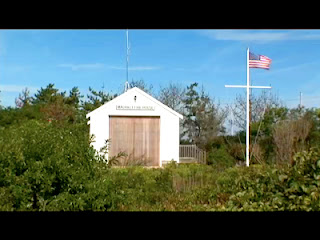 I sincerely hope Chris and I are done with our documentary by next March. Recent events give me some hope to that end, but we have a long, long way to go. Besides, I always imagined the end of the story would find me doing something different than working for MTV (the literal crux of Fred and my initial conversation), and given that I'm knee deep in a new life with Abbigail, and wedding planning, I'm not sure that's going to happen. Either way, Chris and I will be there for the dedication next spring.
I sincerely hope Chris and I are done with our documentary by next March. Recent events give me some hope to that end, but we have a long, long way to go. Besides, I always imagined the end of the story would find me doing something different than working for MTV (the literal crux of Fred and my initial conversation), and given that I'm knee deep in a new life with Abbigail, and wedding planning, I'm not sure that's going to happen. Either way, Chris and I will be there for the dedication next spring.Plans call for a $3 million sculpture of children's television legend Fred Rogers to be placed on an observation deck bored into an old bridge pier on the North Shore. The 10-foot-tall sculpture shows Mr. Rogers tying his shoes, as he did at the beginning and end of every episode of "Mister Rogers' Neighborhood."
A keyhole shape will be bored into the Manchester Bridge Pier, close to the south entrance to Heinz Field, framing a new view of the Point and giving an entrance to the childhood icon's "living room."
Children will be encouraged to scramble onto the statue -- by the same sculptor who did Mayor Richard S. Caliguiri's on Grant Street -- and construction materials will mimic the "Neighborhood" studio set.
Officials hope the privately funded parklet will become a major sight-seeing destination in the city and the setting for generations of snapshots with Mr. Rogers or the city's keyhole-framed skyline as a backdrop.
The site "creates a distinctive sense of place, a place that fosters civic pride, creates fun and ... recognizes our children and the importance of our children to the future of this community," said William H. Isler, the president of Mr. Rogers' production company, Family Communications.
The project is funded by Colcom Foundation, the $500 million charitable foundation of the late Cordelia S. May, a longtime Rogers family friend. The foundation paid $1.3 million for the sculpture and $1.7 million for developing the parklet plans, and promised to pay for the site's future maintenance.
Supporters stressed the site is not a Fred Rogers memorial. Rather, they are calling it "A Tribute to Children," with hopes it can be a gathering place for children and families.
The old bridge abutment currently sits unadorned along the Allegheny riverfront trail. The city-county Sports & Exhibition Authority once proposed turning it into an observation deck, much like the designers of the Rogers project -- Pittsburgh-based Astorino -- are now planning.
Plans are to circle the statue and elevated observation deck with a railing, creating a 4,100-square-foot visiting space.
Over the past four years, designers looked throughout the city at locations that would make the most of the statue, which Mrs. May commissioned in 2003. Colcom Foundation leaders wanted it near the Point, but with Point State Park being redeveloped, instead focused on the pier, Mr. Isler said, for its high visibility and accessibility to transportation and visitors.
"The site is highly visible -- from Mount Washington, Fort Duquesne Boulevard, the Golden Triangle, Point State Park -- and each time the three rivers are photographed or filmed, it's seen," lead architect Louis Astorino said. "It's seen on 'Monday Night Football.' It's seen nationally when you look at Pittsburgh."
The city's Art Commission has given preliminary, conceptual approval to the plans, which will go to the city planning commission next month.
Plans call for the statue's site to be completed by March 20, which would have been Mr. Rogers' 80th birthday. Construction is also tied to Pittsburgh's 250th anniversary next year.
Mr. Rogers was born in Latrobe in 1928. He wrote and starred in "Neighborhood" at WQED for 33 years, won the Presidential Medal of Freedom, two Peabody Awards and four Emmys, and was inducted into the Television Hall of Fame in 1999. He died at his Squirrel Hill home in February 2003 at age 74.
The sculptor, Robert Berks, has done many portrait busts and similiar statues of Mr. Caliguiri and Albert Einstein, for the National Academy of Sciences. The Rogers statue will be similar to a child-friendly Hans Christian Anderson statue in New York's Central Park, supporters said, by Georg Lober.
The Rogers statue will be sitting on steps, allowing children access to it, but it will still be oversized. The sculptor, Mr. Astorino said, wanted to convey "the overwhelming awe of seeing this person for the first time as a child."
- Pittsburgh Post-Gazette

